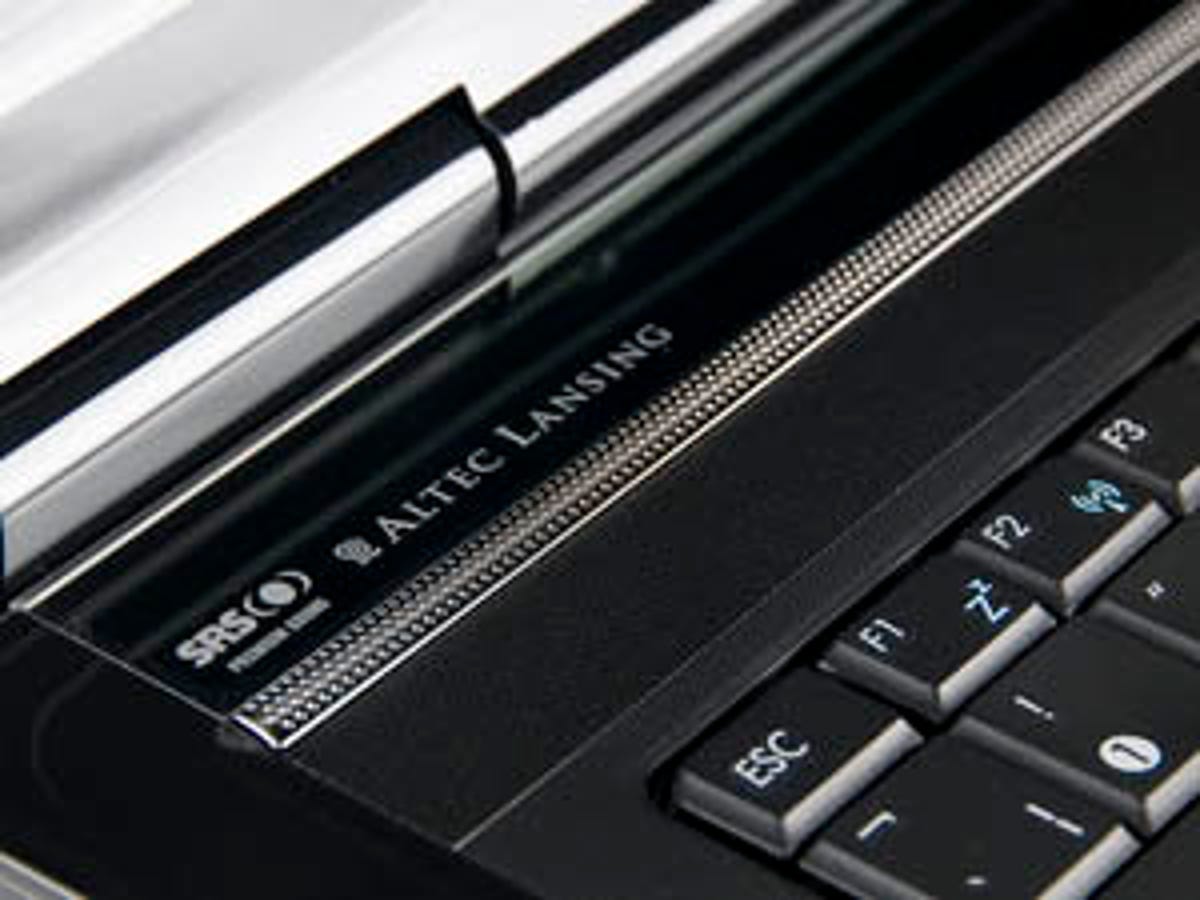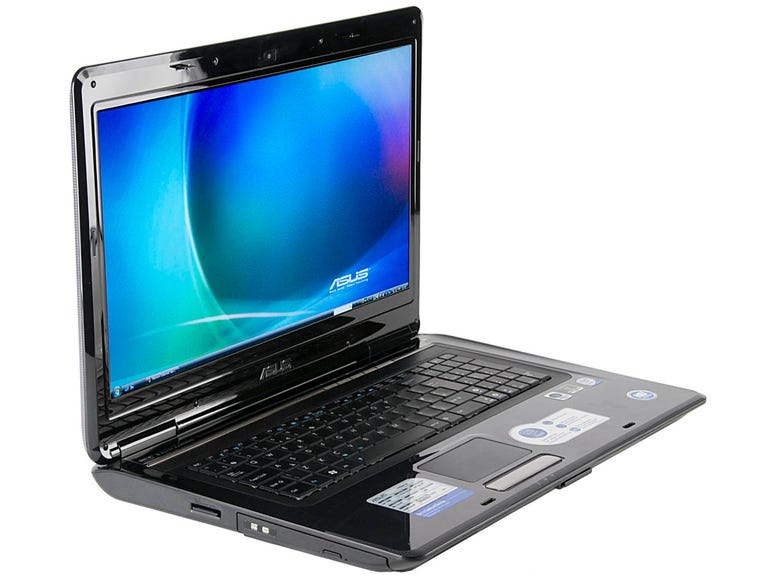 Why You Can Trust CNET
Why You Can Trust CNET Asus F70 review: Asus F70
An unusual 17.3-inch screen is intended to make the Asus F70 laptop stand out from the crowd, with a 16:9 aspect ratio that's perfect for watching movies without seeing black bars at the top and bottom of the picture
The Asus F70 is aimed at the film buff who wants to replace their bulky desktop PC with something a little more portable. Its biggest selling point is a 17.3-inch display with a 16:9 aspect ratio, but it promises to be a fairly competent all-rounder. It's available to buy now for £849.
The Good
The Bad
The Bottom Line
Design
We can't fault the F70's styling. Most machines of this size struggle to impress, but we instantly fell for the subtle swirling patterns in its blue-grey lid, its gently curved edges, and the fact that it isn't a complete beast to lug around. Its 4.1kg, 466 by 309 by 47mm chassis is by no means slender, but it's a far cry from the majority of bloated 17-inch laptops that come our way.

Large laptops tend to have comfortable, easy-to-use keyboards, and the F70 is no different. It uses so-called chiclet keys -- a style of keyboard where each button is concave to better fit the user's fingertips for easier, more accurate typing. Asus also believes that by reducing the space between each key, it's able to offer greater protection against dust. We're not sure what kind of giant dust Asus was testing it with, but where we come from, dust is pretty damn small and won't have any trouble infiltrating this keyboard.
The mouse trackpad is comfortable. It's large, has a dedicated scroll strip on the right for rapidly moving up and down through documents, and has chunky (though not clunky) selector buttons. Between each of these buttons is a fingerprint reader, which makes logging into your user account quicker and easier than typing a password. It's not completely foolproof -- determined hackers can bypass the system -- but it's certainly convenient, and makes a nice complement to the laptop's clever facial recognition system.
Connectivity on the F70 is good, as you'd probably expect from a desktop replacement. It packs four USB ports, an eight-in-one memory card reader supporting MMC, SD, miniSD and xD formats, a modem, Ethernet, headphone-out and microphone-in. It also has a range of ports that should cement its status as a top-rung multimedia laptop. It packs both D-Sub, VGA and HDMI video, plus digital SP/DIF audio output.
Features
Most 17-inch laptops tend to use powerful components in their efforts to compete with the desktop PCs they're designed to replace. The F70, however, doesn't seem to try very hard. It's available in three separate configurations, none of which will rock your world.
The pick of the bunch is the £859 F70SL (TY076C), which uses an Intel Core 2 Duo T5850 CPU clocked at 2.16GHz, 4GB of DDR2 800MHz memory and a 320GB hard drive. For £20 more, you can buy the TY087E, which gives you just 3GB of RAM and Windows Vista Business instead of Vista Home Premium. Why you'd want to buy that, we're not entirely sure. If the recession hasn’t reached your home, the £949 TY065C comes with a faster Core 2 Duo P8400, 4GB of RAM and a 500GB hard drive.
All three machines use the same 17.3-inch display, which Asus somewhat optimistically refers to as being "full high-definition 1080p". In reality, the screen runs at a modest 1,600x900 pixels -- way off the 1,920x1,200 pixels required to qualify as 'full HD'. That gripe aside, the image quality on the F70 is very good. The viewing angle is wide enough for multiple users to watch a movie side by side, and its 16:9 aspect ratio means DVD movies in particular fit without unsightly image stretching or black bars at the top and bottom of the screen.
The graphics card isn't much cop either -- Asus has bizarrely chosen to supply an Nvidia GeForce 9300 graphics processing unit, which is the sort of thing you might find in a high-end netbook or mid-range laptop. It'll run games and high-definition movies, but it's a poor choice in a £900 desktop replacement.
The F70 has decent networking capabilities. The gigabit Ethernet adaptor lets you create wired networks of up to 1,000Mbps instead of the usual 100Mbps -- so long as your other networked devices are gigabit Ethernet-compatible. Its wireless capabilities are also impressive. Bluetooth 2.1+EDR is present, alongside 802.11b/g/n -- so you can connect to high-speed Wi-Fi hotspots.
The software package on all models consists of Asus Express Gate, a fast-booting, pre-Windows graphical user interface, Norton Internet Security 2008, Nero 8 Essentials, and Asus SmartLogon facial recognition software. Each version of the F70 has a two-year global collect and return warranty.
Performance
The F70's performance is fairly mediocre for a desktop replacement. The Core 2 Duo T5850 in our test sample is a capable enough CPU that will handle most everyday tasks without struggling, but it's hardly the sort of thing worth writing home about. Unfortunately it failed to return a PCMark 2005 score due to a hardware incompatibility, but it was fairly average in anecdotal testing.
The Nvidia GeForce 9300 graphics card was mediocre, too. It scored 1,803 in our 3DMark 2006 benchmark, which indicates it'll cope with the odd game and pump out HD movies, but again, any parents trying to palm this off on to their adolescents will be met with scorn, resentment and possibly even parent-offspring divorce.
Battery life was surprisingly decent for such a large machine. The F70 lasted 4 hours 33 minutes in our BatteryEater classic test, which exceeds the average for 17-inch desktop replacement laptops. We're not sure we'd want to take the F70 any place without an AC outlet nearby, but it's useful to know it won't conk out the minute you remove the power supply.
Conclusion
The F70 is difficult to recommend. Asus believes it'll make a great desktop replacement that appeals to movie buffs, but its equipment levels are uninspiring, its screen is mediocre, and it doesn't represent particularly good value next to laptops such as the Dell Studio 17.
Edited by Jason Jenkins
